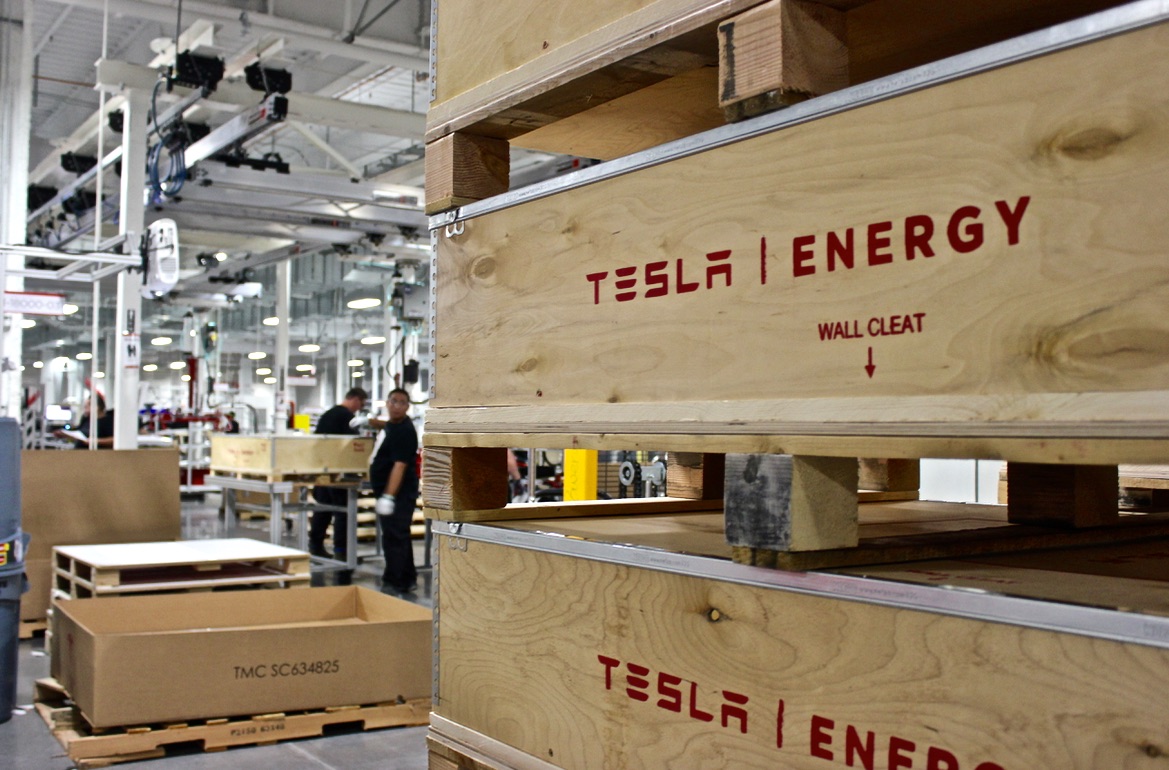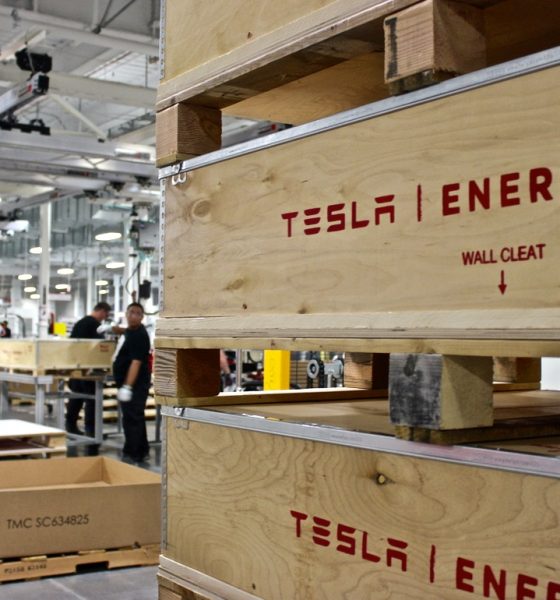

Energy
Tesla’s Director of Battery Engineering has reportedly left the company
Tesla’s Director of Battery Engineering, Jon Wagner, has reportedly left the company to focus on a new role at a battery and powertrain startup in Redwood City, CA. The report, first surfaced on Jalopnik, states that Wagner departed Tesla in October, despite his LinkedIn profile still showing that he’s currently employed by the Silicon Valley electric car maker.
Wagner, who’s been at Tesla since 2013, has served as Tesla’s Interim Director for Body Engineering, Computer Aided Engineering, Materials, and Battery Manufacturing Engineering throughout his near five-year term. During his time at Tesla, Wagner led the cost-down and product improvement effort for Model S and Model X’s battery pack. He also pushed research and development efforts that would ultimately translate into technological innovation for Tesla’s Powerwall and Model 3.
According to the United States Patent and Trademark Office (USPTO), Wagner is one of the inventors on a patent that was filed by Tesla for an Energy storage system with heat pipe thermal management. We’ve provided background for the patent as outlined by the USPTO.
Energy storage systems are used in a variety of contexts. For example, an electric vehicle can have a number of individual energy storage units (e.g., lithium-ion cells) stored inside a compartment, and this system is often referred to as a battery pack. Cells and other storage units generate heat during operation, such as during the charging process and when the cells are used to deliver energy, for example to the propulsion/traction system of the vehicle.
One cooling approach currently being used involves lithium-ion cells that are electrically connected by an anode terminal at the bottom of the cell, and a cathode terminal on top of the cell. These cells are arranged to all have the same orientation (e.g., “standing up”) with some spacing provided between all adjacent cells. The spacing facilitates a cooling conduit to run between the cells and be in contact with at least a portion of the outer surface of each cell. The cooling conduit has a coolant flowing through it, which removes thermal energy from inside the battery pack to some location on the outside, where heat can be safely dissipated. In order to provide a safe coolant flow, one must provide fluid connections into and out of the battery package, and the coolant path inside the battery pack must be reliable and have enough capacity.
Wagner’s departure comes at a critical time for Tesla, as it continues to work through battery production challenges being faced at the Gigafactory, and looks to prove to the consumer market that the company’s ‘holy grail’ vehicle, Model 3, will be able to reach volume production of 5,000 vehicles per week by the end of March 2018.
The Silicon Valley electric car maker noted in its third quarter 2017 earnings report that some of the manufacturing processes for Model 3’s battery modules needed to be redesigned, thus delaying the company’s original plan to begin volume production in December by three months. “To date, our primary production constraint has been in the battery module assembly line at Gigafactory 1, where cells are packaged into modules.” read the statement from Tesla in its update letter.
Tesla CEO Elon Musk provided additional background during a Q&A call with analysts, noting that much of the software that was needed for battery module production had to be redesigned. “We had to rewrite all of the software, from scratch. We managed to write 20 to 30 man-years of software in 4 weeks.” said Musk in explaining the level of reprogramming needed for the manufacturing robots.
As senior leaders at Tesla continue to depart, one has to question whether Wall Street’s love and hate stock and Silicon Valley’s sweetheart is biting off more than it can chew. Are these turnovers early indication that Tesla might be headed for a major downturn in 2018 or is it all par for the course?

Cybertruck
Tesla updates Cybertruck owners about key Powershare feature

Tesla is updating Cybertruck owners on its timeline of a massive feature that has yet to ship: Powershare with Powerwall.
Powershare is a bidirectional charging feature exclusive to Cybertruck, which allows the vehicle’s battery to act as a portable power source for homes, appliances, tools, other EVs, and more. It was announced in late 2023 as part of Tesla’s push into vehicle-to-everything energy sharing, and acting as a giant portable charger is the main advantage, as it can provide backup power during outages.
Cybertruck’s Powershare system supports both vehicle-to-load (V2L) and vehicle-to-home (V2H), making it flexible and well-rounded for a variety of applications.
However, even though the feature was promised with Cybertruck, it has yet to be shipped to vehicles. Tesla communicated with owners through email recently regarding Powershare with Powerwall, which essentially has the pickup act as an extended battery.
Powerwall discharge would be prioritized before tapping into the truck’s larger pack.
However, Tesla is still working on getting the feature out to owners, an email said:
“We’re writing to let you know that the Powershare with Powerwall feature is still in development and is now scheduled for release in mid-2026.
This new release date gives us additional time to design and test this feature, ensuring its ability to communicate and optimize energy sharing between your vehicle and many configurations and generations of Powerwall. We are also using this time to develop additional Powershare features that will help us continue to accelerate the world’s transition to sustainable energy.”
Owners have expressed some real disappointment in Tesla’s continuous delays in releasing the feature, as it was expected to be released by late 2024, but now has been pushed back several times to mid-2026, according to the email.
Foundation Series Cybertruck buyers paid extra, expecting the feature to be rolled out with their vehicle upon pickup.
Cybertruck’s Lead Engineer, Wes Morrill, even commented on the holdup:
As a Cybertruck owner who also has Powerwall, I empathize with the disappointed comments.
To their credit, the team has delivered powershare functionality to Cybertruck customers who otherwise have no backup with development of the powershare gateway. As well as those with solar…
— Wes (@wmorrill3) December 12, 2025
He said that “it turned out to be much harder than anticipated to make powershare work seamlessly with existing Powerwalls through existing wall connectors. Two grid-forming devices need to negotiate who will form and who will follow, depending on the state of charge of each, and they need to do this without a network and through multiple generations of hardware, and test and validate this process through rigorous certifications to ensure grid safety.”
It’s nice to see the transparency, but it is justified for some Cybertruck owners to feel like they’ve been bait-and-switched.
Energy
Tesla starts hiring efforts for Texas Megafactory
Tesla’s Brookshire site is expected to produce 10,000 Megapacks annually, equal to 40 gigawatt hours of energy storage.

Tesla has officially begun hiring for its new $200 million Megafactory in Brookshire, Texas, a manufacturing hub expected to employ 1,500 people by 2028. The facility, which will build Tesla’s grid-scale Megapack batteries, is part of the company’s growing energy storage footprint.
Tesla’s hiring efforts for the Texas Megafactory are hinted at by the job openings currently active on the company’s Careers website.
Tesla’s Texas Megafactory
Tesla’s Brookshire site is expected to produce 10,000 Megapacks annually, equal to 40 gigawatt hours of energy storage, similar to the Lathrop Megafactory in California. Tesla’s Careers website currently lists over 30 job openings for the site, from engineers, welders, and project managers. Each of the openings is listed for Brookshire, Texas.
The company has leased two buildings in Empire West Business Park, with over $194 million in combined property and equipment investment. Tesla’s agreement with Waller County includes a 60% property tax abatement, contingent on meeting employment benchmarks: 375 jobs by 2026, 750 by 2027, and 1,500 by 2028, as noted in a report from the Houston Business Journal. Tesla is required to employ at least 1,500 workers in the facility through the rest of the 10-year abatement period.
Tesla’s clean energy boom
City officials have stated that Tesla’s arrival marks a turning point for the Texas city, as it highlights a shift from logistics to advanced clean energy manufacturing. Ramiro Bautista from Brookshire’s economic development office, highlighted this in a comment to the Journal.
“(Tesla) has great-paying jobs. Not just that, but the advanced manufacturing (and) clean energy is coming to the area,” he said. “So it’s not just your normal logistics manufacturing. This is advanced manufacturing coming to this area, and this brings a different type of job and investment into the local economy.”
Energy
Tesla and Samsung SDI in talks over new US battery storage deal: report
The update was related by industry sources and initially reported by South Korean news outlets.

Recent reports have suggested that Tesla and Samsung SDI are in talks over a potential partnership to supply batteries for large-scale energy storage systems (ESS).
The update was related by industry sources and initially reported by South Korean news outlets.
ESS batteries to be built at Samsung’s Indiana plant
As noted in a report from Korea JoongAng Daily, the demand for energy storage systems has been growing rapidly in North America, thanks in no small part to the surge in AI investments across numerous companies. With this in mind, Tesla has reportedly approached Samsung SDI about a potential battery supply deal.
The deal is reportedly worth over 3 trillion Korean won (approximately $2.11 billion) and will span three years, according to The Korea Global Economic Daily. A battery supply deal with Samsung SDI could make sense for Tesla as the company already has a grid-scale battery, the Megapack, which is perfect for industrial use. Samsung SDI could simply supply cells for the EV maker.
Production of the batteries would reportedly take place at Samsung SDI’s joint venture factory with Stellantis in Indiana, which is currently under construction. Samsung SDI recently announced plans to use part of that plant’s EV lines to produce cells for ESS, with a targeted capacity of 30 GWh by the end of next year.
Tesla and Samsung’s partnership
At present, only a handful of manufacturers, including Korea’s LG Energy Solution, Samsung SDI, SK On, and Japan’s Panasonic, are capable of producing energy storage-scale batteries domestically in the United States. A Samsung SDI official issued a comment about the matter, stating, “Nothing has been finalized regarding cooperation with Tesla.”
The possible energy storage system deal adds another layer to Tesla’s growing collaboration with Samsung, which is already in line as a partner in the upcoming production of Tesla’s AI5 and AI6 chips. Early sample manufacturing of the AI6 is expected to begin in South Korea, with mass production slated for Samsung’s Texas-based Taylor foundry when it starts operations.
The AI6 chip will power Tesla’s next wave of high-volume projects, including the Optimus humanoid robot and the autonomous Cybercab service. Musk has called the partnership with Samsung a “real collaboration,” adding that he personally plans to “walk the line” at the Taylor facility to speed up progress.








